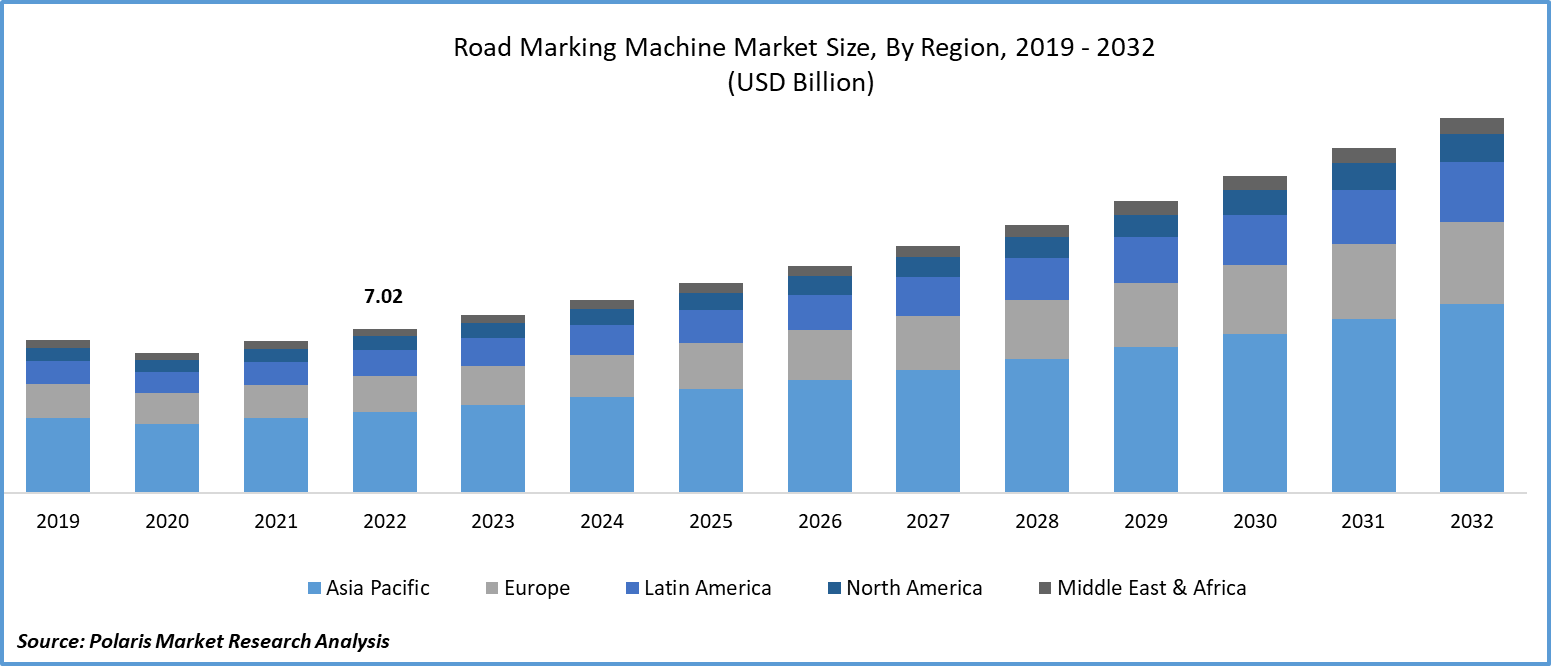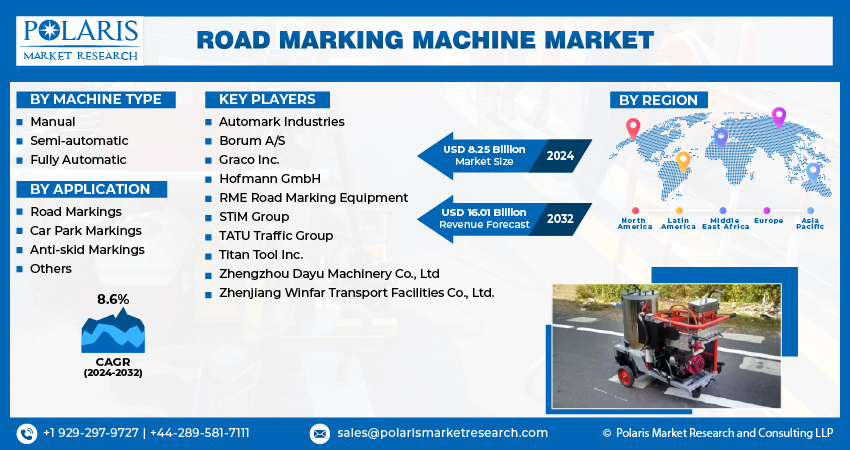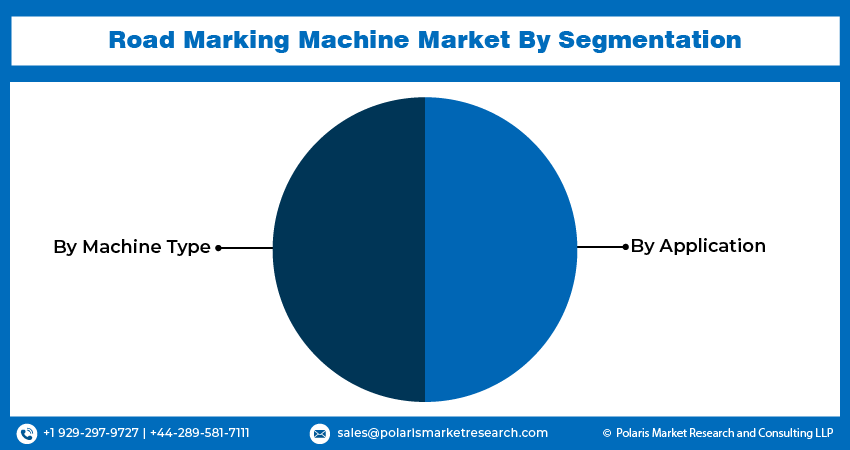
Road Marking Machine Market Share, Size, Trends, Industry Analysis Report, By Machine Type (Manual, Semi-Automatic, Fully Automatic), By Application (Road Markings, Car Park Markings, Anti-skid Markings, Others), By Region, And Segment Forecasts, 2024 - 2032
- Published Date:Jan-2024
- Pages: 118
- Format: PDF
- Report ID: PM4076
- Base Year: 2023
- Historical Data: 2019-2021
Report Outlook
The global road marking machine market was valued at USD 7.61 billion in 2023 and is expected to grow at a CAGR of 8.6% during the forecast period.
The importance of road markings in ensuring road safety and facilitating navigation for drivers and pedestrians cannot be overstated. Consequently, the increasing emphasis on road safety and maintenance is anticipated to fuel the global market in the foreseeable future. Additionally, the forces of globalization, industrialization, and urbanization are set to contribute significantly to market growth. Advancements in technology and heightened awareness among governments worldwide have led to increased investments in road infrastructure. These investments are aimed at achieving balanced regional economic development, enhancing trade and travel, and promoting education. Consequently, the substantial funding from major governments is poised to propel the market forward during the forecast period.

To Understand More About this Research: Request a Free Sample Report
Roads play a vital role in economic growth and development, and maintaining road infrastructure is crucial to preserving and enhancing these benefits. However, in many developing countries, inadequate maintenance has led to irreversible damage to roads, resulting in escalating repair costs and significant economic consequences. Insufficient investments in the maintenance and repair of existing road infrastructure might hinder market expansion during the projected period.
Various manufacturers are concentrating on advancing technologies to enhance the production of road marking machines. The increasing automation of these machines, coupled with the introduction of innovations like dual spray colors using distinct marking materials, is set to drive market growth in the predicted timeframe. The usage of these machines is anticipated to grow significantly, with numerous industry players emphasizing technology-oriented infrastructure development. Governments worldwide are addressing road safety concerns by implementing stringent regulations. Moreover, the adoption of the cold plastic agglomerate machines, aimed at reducing the carbon foot-print, further contributes to the anticipated expansion of the market in the foreseeable future.

Industry Dynamics
Growth Drivers
- Infrastructure Development
Increased investments in infrastructure development, including road construction and maintenance projects, drive the demand for road marking machines.
The use of road marking machines is diversifying across various applications, including airport, bus stop, KERB, and anti-skid markings. These machines are vital for enhancing road safety, aiding navigation for both vehicles and pedestrians. Anticipated growth in global demand for road marking machines is attributed to heightened needs for road safety, maintenance, and increased investments in road infrastructure in emerging economies. Factors such as higher road infrastructure spending, industrial growth, technological advancements, rapid urbanization, and infrastructure expansion are expected to drive the global road marking machine market in the foreseeable future.
Report Segmentation
The market is primarily segmented based on machine type, application, and region.
|
By Machine Type |
By Application |
By Region |
|
|
|
To Understand the Scope of this Report: Speak to Analyst
By Machine Type Analysis
- Manual segment accounted for the largest market share in 2022
Manual segment held the largest revenue share. This segment involves hand-pushed RMMs, a type of machine operated manually by individuals. These machines find widespread use in various applications, including marking bus stops, creating parking spaces around buildings, outlining railway platforms, demarcating areas on factory floors, and marking lines at city crossroads. Manual RMMs are versatile tools employed for precise and controlled road marking in diverse settings, offering flexibility and accuracy in marking specific areas according to the required guidelines and designs.
Automatic segment will grow rapidly. These machines are advanced, featuring sensor-based or laser-based technology, ensuring high precision and specific line thickness over long distances. They are particularly well-suited for highway road marking tasks and the maintenance and repair of road markings. Following closely, the semi-automatic segment is anticipated to be the second-fastest growing category. These machines require manual oversight alongside software assistance, enabling partial automation. They can either be self-propelled or mounted on a van, and in some cases, they are hand-pushed, combining manual and automated operations.
By Application Analysis
- Car park marking segment held the largest share in 2022
Car park marking segment will grow rapidly. increasing number of cars on the roads has led to a heightened demand for parking spaces. To efficiently manage these spaces, advanced automation systems are being deployed, necessitating clear and visible road markings. Secondly, there is a growing awareness about road safety, prompting the implementation of precise and well-defined markings to enhance safety for both drivers and pedestrians. Additionally, as urban areas continue to expand, the need for accommodating the rising number of vehicles and parking spaces becomes paramount, further fueling the demand for effective car park marking solutions.

Regional Insights
- Asia Pacific dominated the global market in 2022
APAC emerged as the largest region. substantial increase in expenditures dedicated to road infrastructure projects. Countries within the region are actively investing in enhancing their road networks to support economic growth and facilitate smoother transportation. India stands out with the second-largest road network globally, covering an extensive length of approximately 5.6 kms/day. The country's rapid population growth, coupled with ongoing urbanization efforts, is creating a surge in the demand for expanded road networks. To accommodate this demand, there is a pressing need for advanced road marking solutions.
Additionally, the Indian government's initiatives, such as "Make in India," are playing a pivotal role in stimulating the demand for road marking machines. This campaign, designed to promote local manufacturing and attract foreign investment, has attracted numerous global manufacturers of road marking machines to establish their operations in India. This influx of international expertise and technology is expected to further drive the market growth in the region, ensuring its continued dominance in the global market.
Latin America region will grow rapidly. This region presents abundant potential and promising opportunities within the road marking machine industry. Notably, countries like Brazil and Argentina, which are pivotal economies in the region, are significantly increasing their investments in road infrastructure projects. Unique combination of extensive roadways and a sizable population underscores Brazil's substantial potential in the market. The country's proactive approach is evident in its plans to escalate spending on road infrastructure initiatives throughout the forecast period.

Key Market Players & Competitive Insights
Major road marking machine manufacturers are strategically diversifying their market reach by venturing into emerging economies. These countries represent thriving markets with increasing demands for robust road infrastructure, including well-defined markings for efficient traffic management and enhanced road safety.
Some of the major players operating in the global market include:
- Automark Industries
- Borum A/S
- Graco Inc.
- Hofmann GmbH
- RME Road Marking Equipment
- STiM Group
- TATU Traffic Group
- Titan Tool Inc.
- Zhengzhou Dayu Machinery Co., Ltd
- Zhenjiang Winfar Transport Facilities Co., Ltd.
Recent Developments
- In February 2023, WJ, unveiled a ground-breaking innovation in the UK known as ThermoPrint. This automated machine eliminates the necessity for manual application of thermoplastic road markings. ThermoPrint scans existing markings, compares them to programmed designs, and then applies thermoplastic to refresh and enhance them to meet the required standards. This cutting-edge technology is not only set to enhance road safety but also transform the road marking industry significantly.
- In June 2023, LimnTech Scientific selected the Advanced Navigation Certus MEMS INS for precise and automated road marking in both urban and rural settings. Certus delivers enhanced performance even in areas with degraded GNSS signals and seamlessly integrates into existing setups. This system plays a crucial role in minimizing injuries and fatalities in dangerous environments.
- In November 2021, Balaji Road Marking Machines (SBRMM) introduced PRAGATI-NG, India's inaugural automatic road marking machine produced domestically. This innovative equipment has a marking capacity of up to four kilometers per hour and incorporates audio tactile or rumble markings.
Road Marking Machine Market Report Scope
|
Report Attributes |
Details |
|
Market size value in 2024 |
USD 8.25 billion |
|
Revenue forecast in 2032 |
USD 16.01 billion |
|
CAGR |
8.6% from 2024 – 2032 |
|
Base year |
2023 |
|
Historical data |
2019 – 2021 |
|
Forecast period |
2024 – 2032 |
|
Quantitative units |
Revenue in USD billion and CAGR from 2024 to 2032 |
|
Segments covered |
By Machine type, By Application, By Region |
|
Regional scope |
North America, Europe, Asia Pacific, Latin America; Middle East & Africa |
|
Customization |
Report customization as per your requirements with respect to countries, region and segmentation. |
